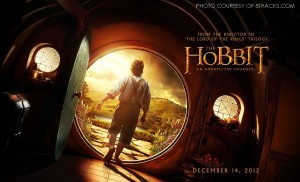
With the unveiling of The Hobbit project nearly two years ago, Tolkien fans were restless with anticipation and apprehension.
Jackson has once again created a beautiful, adrenaline-pumping prequel to his famous productions of The Lord of the Rings.
Viewers who had never read the books had nothing to worry about; Jackson included a prologue in the beginning of the film to introduce the main characters.
Dealt a cruel hand by the dragon Smaug, the dwarves of Erebor, an underground kingdom, had been forced to wander Middle Earth for years. That is, until one day, signs appear in the sky that foretell the fall of the dragon. The time was right for the dwarves to reclaim their homeland.
Bilbo Baggins, played by Martin Freeman, had been living a quiet life in his cozy hobbit hole until Gandalf the Grey, played again by Ian McKellan, invaded the quiet monotony of his everyday life. Gandalf decided, without Bilbo’s permission, to recruit him for the dwarves’ quest, exposing him to the cruelties and dangers of the world beyond the Shire.
The story precipitates all of the events that occurred in the original Lord of the Rings movies. It tells the tale of how Bilbo came to acquire the One Ring and his famous “sword”, Sting. It provides a refreshing background story to Lord of the Rings.
However, there have been some arguments amongst critics and avid Tolkien fans concerning the “artistic interpretation” that Jackson took on the book. Taking a look at the size of the Lord of the Rings trilogy and the Hobbit book, anyone can see that the content within the Hobbit does not merit three movies. There simply is not enough plot line. This begs the question: why did the Lord of the Rings earn three movies – one for each book – when the Hobbit is a single book that is being made into a trilogy as well?
Some critics claim that Jackson simply wants to make more money, knowing that Tolkien fans will likely pay full-price to see the much-anticipated movies. Whatever the case, these same critics complain that Jackson created a meandering plot that would hopefully sustain throughout three movies. Not all viewers agreed with these critics, though.
Despite these outcries, the movie was altogether well put together and well-enjoyed by the vast majority of its audience. Taking on a more light-hearted mood than the Lord of the Rings trilogy, the film is riddled with humor. Bilbo is portrayed as a chill, relaxed hobbit who is subconsciously repressing a desire to explore and see the world.
Once the dwarves came banging through his door, the comical confusion and shock on Bilbo’s face is priceless. As the dwarves rummage through his pantry and create a wasteland through his tidy hobbit-hole, he ran about in a frenzy, trying to restore order. His frantic antics created laughter that rippled throughout the audience, introducing the first of many hilarious scenes.
In between these moments of comic relief, however, there were moments when the audience would be perched on the edge of their seats, gnawing on their nails as tension mounted. In the scene with Gollum, Bilbo, and the game of riddles, though, Jackson truly showed his worth.
Many are familiar with this story: to stay alive, Bilbo must play a game of riddles with Gollum. If he won, he was freed and shown the way out. If he lost…he became lunch. This was probably the creepiest and most tension-infused scene in the movie. Once he escaped, the audience breathed a collective sigh of relief.
The movie captured its audience with its magical essence, inciting laughter one moment and inspiring fear and apprehension the next. Though much-bashed by its picky critics, it was a fantastic representation of the novel. The minor plots and conflicts that Jackson had added to prolong the running time did not take anything away from the overall story. In fact, they merely added to it, creating an all-around epic movie.

Leave a Reply